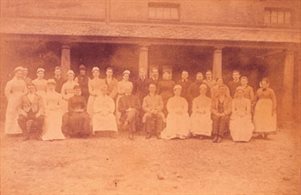The Servants’ Quarters
 The completeness of the domestic offices at Tatton gives a striking picture of the world of the servants below stairs and the scale of household management which was required to run such a large establishment with efficiency and precision.
The completeness of the domestic offices at Tatton gives a striking picture of the world of the servants below stairs and the scale of household management which was required to run such a large establishment with efficiency and precision.
At the end of the 19th century the Egerton household had around 40 indoor servants under the control of the housekeeper and house steward.
The Scullery and Kitchen
Like all country houses, Tatton was self-sufficient, having its own home farm and extensive walled kitchen gardens of six and a half acres. The scullery and kitchen were relocated to their current position at the western end of the main house at the end of the 18th century setting them closer to the Walled Kitchen Garden and Home Farm.
Both rooms face north and are well lit by large windows, without being exposed to excessive sunlight. The lofty airiness of these rooms, together with the easily washable tiled brick walls and stone floors, make them ideal work-places for the job of preparing meals for the family and household.
The position of the kitchen was important in relation to the other parts of the building, being close to the courtyard entrance for the delivery of supplies from other parts of the estate. The distance from the Dining Room was equally important, as the kitchen had to be near enough for efficient service, but far enough away to ensure cooking smells did not penetrate into the family rooms.
Salting Room and Wine Cellar
At the far end of the passage are the rooms under the control of the housekeeper and cook, accessible from a second set of stairs.
Conveniently situated near the outer door to the kitchen courtyard is the salting room. Preserving food in the days before refrigeration was an essential part of household management. Tatton was well placed in the heart of the Cheshire salt mining industry for obtaining large quantities of salt required for preserving the carcasses of bacon and ham joints produced from pigs reared at Home Farm. After being pickled in saltpetre, sugar, salt and water, the joints were wrapped in muslin and hung on the overhead hooks to provide the household with meat throughout the winter.

At the hub of all country estates were the cellars, where supplies of food, wine and fuel were stored and later, water was heated in the boiler-houses. The butler had control of the wine and beer cellars along with the coal store, all of which were situated within easy reach of the butler's pantry upstairs.
In the wine cellar, the butler kept account of the stock of wines and labelled each of the bins for easy reference. The outer part of this cellar was used as a receiving cellar for unpacking and washing bottles, and for recording stocks as they arrived. Three enormous Cellar Books survive covering the period 1844 to 1909 during three generations of Egerton ownership. Over the 66 years recorded, 51,000 bottles were listed here for consumption by the Egerton household either at Tatton or at their other houses.